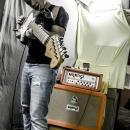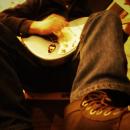Existe en Gearslutz la traslación de una entrevista a Dave Jerden de la forma en que grabaron las guitarras del "Dirt", en ella se especifica que utilizaron 3 amplificadores en pila: un Vox para los graves, un bogner o mesa boogie para los medios y un bogner o soldano para los agudos. Micros cercanos se usaron SM57 y 421, micros de sala C12, U47 y U49, mezcla de micros: cercano 80%, sala 20%, más un trillón de overdubs que usaron.
Aquí te la dejo:
What are some of the techniques that you use to record guitars?
On the first Alice in Chains record, Facelift. Jerry Cantrell and I had several amps, and were trying to find sounds on each one. I said, “Lets combine them.” Usually when you combine amps you end up with nothing but mud. But I came across the idea of using different amps for different frequency ranges. That could mean ,for example, using a Vox AC30 closed back for the low end, a Marshall or Bogner Ecstasy or a Mesa Boogie for the midrange, and then using something like a Bogner Fish preamp or Soldano preamp for the top end- something thast I could get a real hard bite from on top. I record those on separate tracks. They all go down at the same time, and then sometimes I double that.
So the first set of three is one performance……..
One performance. My Engineer Brian Carlstrom and I have been making our own active splitter boxes to help deal with hums, buzzes, and all that. The cable comes out of the guitar and the box splits the signal to the three amps. But I just did an album in the Bahamas last year at Terry Mannings studio (who is also a great engineer) and Terry invented an active splitter box with one in and six outs. It has ground lift switches to take care of grounding problems and it works like magic.
And the whole point of having the box is so the pickups aren’t loaded down making the guitar sound different.
Exactly. Even the length of the guitar cable can kill the tone. When we’re doing basic tracks, the guitar and bass players are in the control room with the amp heads, and this makes the leads shorter. Keeping the guitar leads short is important because long leads can really take down the high end.
Do you have particular mics that you use for the three amp set-up?
The mainstay for me has been the Shure SM57. We always keep relatively new ones around and we front and back mic open back cabinets with them. I also use AKG C12’s for pulling out the room sound a little bit, or Neumann U47’s or U49’s are great mics for the room. But I don’t tale a $10,000 mic and put it right on a Marshall cabinet. A 57 will get the sound for me.
How much of the mix is there between the close and distant mics?
Probably 20 percent room as opposed to the close mic, and those mics go down to the same track.
When using the multiple amp technique, do the amps go into separate areas or into one room?
There’s two set-ups that I use: one is for basic tracks and the other is for overdubs. When I am doing the basic track, I am not sire if it is going to be a keeper, so I will isolate the guitar and bass amps from the drum room. But, when I actually do guitar overdubs, we pull all of the guitar cabinets ( the heads always stay in the control room) out in the main room and then I have the option of using room mics on them too.
When you mic the front and back of an open back amp, are you generally using a 57 in front and a 57 in back?
It can be a 57 or sometimes I use 421’s. Sometimes it’s a 57 in front and a 421 in back. It varies.
More to come....................
Aquí te la dejo:
What are some of the techniques that you use to record guitars?
On the first Alice in Chains record, Facelift. Jerry Cantrell and I had several amps, and were trying to find sounds on each one. I said, “Lets combine them.” Usually when you combine amps you end up with nothing but mud. But I came across the idea of using different amps for different frequency ranges. That could mean ,for example, using a Vox AC30 closed back for the low end, a Marshall or Bogner Ecstasy or a Mesa Boogie for the midrange, and then using something like a Bogner Fish preamp or Soldano preamp for the top end- something thast I could get a real hard bite from on top. I record those on separate tracks. They all go down at the same time, and then sometimes I double that.
So the first set of three is one performance……..
One performance. My Engineer Brian Carlstrom and I have been making our own active splitter boxes to help deal with hums, buzzes, and all that. The cable comes out of the guitar and the box splits the signal to the three amps. But I just did an album in the Bahamas last year at Terry Mannings studio (who is also a great engineer) and Terry invented an active splitter box with one in and six outs. It has ground lift switches to take care of grounding problems and it works like magic.
And the whole point of having the box is so the pickups aren’t loaded down making the guitar sound different.
Exactly. Even the length of the guitar cable can kill the tone. When we’re doing basic tracks, the guitar and bass players are in the control room with the amp heads, and this makes the leads shorter. Keeping the guitar leads short is important because long leads can really take down the high end.
Do you have particular mics that you use for the three amp set-up?
The mainstay for me has been the Shure SM57. We always keep relatively new ones around and we front and back mic open back cabinets with them. I also use AKG C12’s for pulling out the room sound a little bit, or Neumann U47’s or U49’s are great mics for the room. But I don’t tale a $10,000 mic and put it right on a Marshall cabinet. A 57 will get the sound for me.
How much of the mix is there between the close and distant mics?
Probably 20 percent room as opposed to the close mic, and those mics go down to the same track.
When using the multiple amp technique, do the amps go into separate areas or into one room?
There’s two set-ups that I use: one is for basic tracks and the other is for overdubs. When I am doing the basic track, I am not sire if it is going to be a keeper, so I will isolate the guitar and bass amps from the drum room. But, when I actually do guitar overdubs, we pull all of the guitar cabinets ( the heads always stay in the control room) out in the main room and then I have the option of using room mics on them too.
When you mic the front and back of an open back amp, are you generally using a 57 in front and a 57 in back?
It can be a 57 or sometimes I use 421’s. Sometimes it’s a 57 in front and a 421 in back. It varies.
More to come....................



